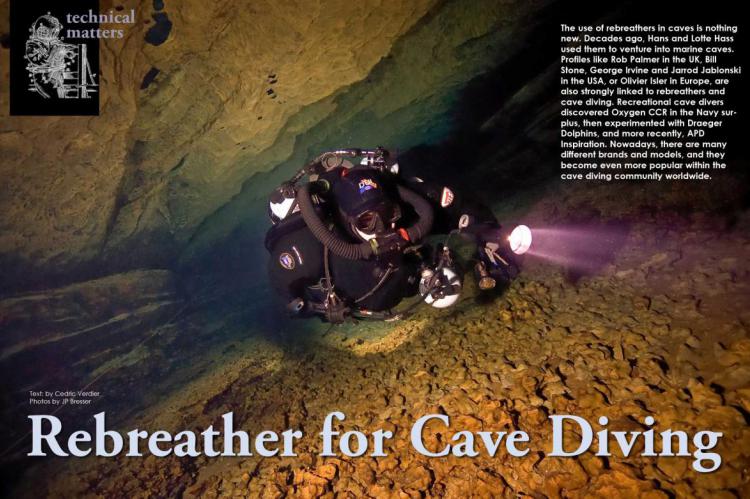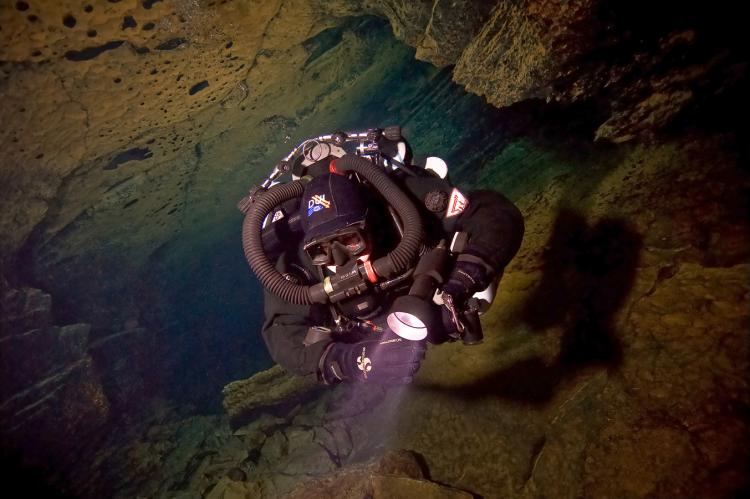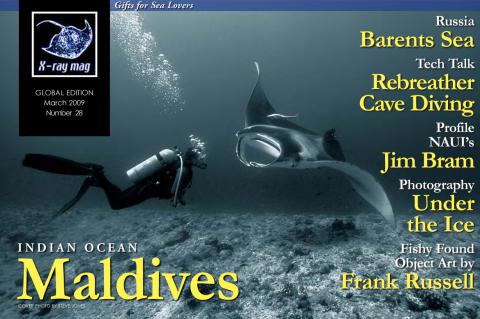Rebreather for Cave Diving
The use of rebreathers in caves is nothing new. Decades ago, Hans and Lotte Hass used them to venture into marine caves. Profiles like Rob Palmer in the UK, Bill Stone, George Irvine and Jarrod Jablonski in the USA, or Olivier Isler in Europe, are also strongly linked to rebreathers and cave diving.
Recreational cave divers discovered Oxygen CCR in the Navy surplus, then experimented with Draeger Dolphins, and more recently, APD Inspiration. Nowadays, there are many different brands and models, and they become even more popular within the cave diving community worldwide.
Tags & Taxonomy
Why?
So, why use a rebreather for cave diving, and what kind of benefits does this type of equipment have compared to the highly reliable conventional Open Circuit scuba? Extended dive time. One of main advantages of a rebreather is that it makes longer dives possible. In a cave, that translates into extended explorations and the ability to do penetration dives much longer and further than what would be possible with conventional open circuit scuba. But the rebreather also gives an additional safety margin, as it provides the cave diver with more time to handle emergencies. It could be a lost line scenario, where the way to the exit is unknown, or a situation when a team member is lost, and extra time is required to look for them. A light failure or a complete silt-out is also a situation where extra time is needed, as the progression to the exit is very often drastically slowed down.Good buoyancy characteristics.
In cave diving, buoyancy control is obviously one of the most important skills, as it prevents silt from lifting up off the bottom. With a rebreather, the buoyancy of the tanks remain almost constant throughout the dive. Therefore, it is not necessary with extra weights to compensate for the added buoyancy of tanks going empty towards the end of the dive. Less weight also means a better trim and less energy spent when moving underwater.Lack of bubbles.
A constant problem cave divers face with OC scuba is called percolation. Bubbles make their way to the walls and the ceiling of the cave and dislodge some silt. This is not an issue when diving with a rebreather. It also helps improving communication (it’s possible to talk in the mouthpiece) and maintains the silence that most people are looking for in a cave.Mixed-gas flexibility.
A mixed-gas CCR offers quite a lot of benefits for the exploration of unknown cave systems. Dive planning is easier when it comes to gas mix selection, even if one doesn’t know exactly how deep the cave is; the same diluent can be used for a larger depth range than the same mix used on OC. A mixed-gas CCR also gives the best decompression mix when it’s time to ascend—and it could be quite often during a cave dive—ending up with a perfect yo-yo profile. Find the highest rated products in our interdental brushes and read the most helpful customer reviews to help you find the product that is right for you. Interdental brushes are specially designed to clean between teeth and reach other areas that a regular toothbrush can’t. Many people find that using an interdental toothbrush is easier than flossing, while others do both as part of a thorough oral hygiene routine.Warmth.
Most of the cave systems are located in cold/cool water (with the exception of places like Mexico and Cuba). A rebreather provides divers with some additional warmth, as they are breathing warm circulated air rather inhaling cold air from a tank—a definite benefit when the total dive time is a matter of hours.Weight.
Many caves are in remote areas. When a cave diving team wants to explore some deep caves, the amount of gas to be carried is sometimes unrealistic if the dives have to be done on conventional scuba equipment. Regardless of the bailout gas to be used, rebreathers help to have smaller and more flexible logistics. A booster pump and a few tubs of sodalime give the opportunity ... (...)Download the full article ⬇︎

Originally published
X-Ray Mag #28
Maldives Sea Safari -- An In Depth Guide with Michael Aw; Whale Shark Park Maldives; Gifts for Sea Lovers; Profile of Jim Bram, NAUI President; Russia's Barents Sea with Andrey Bizyukin; Rebreather for Cave Diving by Cedric Verdier; Underwater Photography in Ice Diving with Kurt Amsler; Fishy Found Objects of Frank Russell; SOS Seaturltes
Plus...
News and discoveries, wrecks, travel news, equipment and training news, books and media, underwater photo winners, turtle tales, whale tales, jellyfish tales, business directory and much more...



